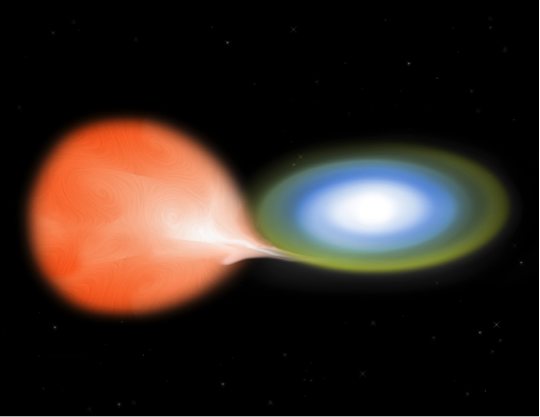Radioactive emission from classical novae
In classical nova explosions gamma-rays are expected from positron-electron annihilation; positrons are emitted by the β+-unstable short-lived isotopes 13N and 18F (lifetimes 862 s and 158 min, respectively), and to a lower extent by 22Na. Therefore, prompt emission consisting of a 511 keV line plus a continuum below this energy (with a cut-off at 20 – 30 keV) is expected, with very short duration. In addition, gamma-ray lines at 478 keV (7Be decay in CO novae, lifetime 77 days) and 1275 keV (22Na decay in ONe novae, lifetime 3.75 years), are expected to last a couple of months and years, respectively.
 Artist’s illustration of a classical nova binary system. Credit: NASA/CXC/M. Weiss. |
Required instrument performances:
A FOV as wide as possible will be needed to detect the 511 keV line and the continuum below, since it has very short duration and appears before the optical discovery of the nova. On the other hand, detection of the 1275 keV only needs pointed observations.
| Performance parameter | Goal value | Remarks and notes |
|
Field-of-view (FWHM, deg) |
Very broad (511 keV line and continuum) no restrictions (478 and 1275 keV lines) |
511 keV line and continuum below it can only be detected by « a posteriori » analysis of the data ; monitoring of the « whole sky » |
|
Angular resolution (FWHM, deg) |
No constrains | |
|
Spectral resolution (ΔE/E @ Energy) |
1-2% | Lines are broad with delta_E/E=1.5% |
|
Line sensitivity (@ Energy) (cm-2 s-1, 3σ, 1 Ms) |
6×10-7 ph/cm2/s (for t_obs=1Ms) @ 1275 keV 10-5 ph/cm2/s @ 511 keV (for t_obs=1 hour) |
Detection of novae up to 5 kpc (1275 keV) ; only ONe novae ; 1/year approx. Broad line (1.5%) Detection of novae up to 5 kpc |
|
Continuum sensitivity (in which energy band?) (cm-2 s-1 keV-1, ΔE=E, 3σ, 1 Ms) |
(50-150) keV ≈10-4 ph/cm2/s/keV TBC (for t_obs=1-2 hour) |
|
| Timing performances | not needed | |
|
Polarimetric capability (Minimum Polarization Fraction for a Crab source in 1 Ms) |
not needed |
|
| Real-time data? | not needed |
 AstroMeV
AstroMeV